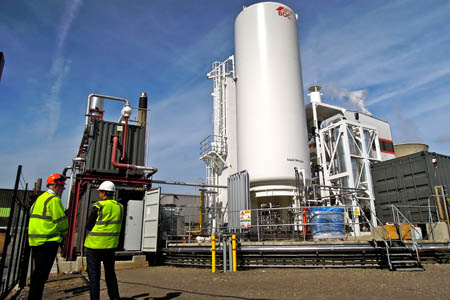A British company has unveiled what it claims is the solution to one of windpower’s major drawbacks: storage of surplus energy which can then be released during periods of calm.
Highview Power Storage uses liquid air storage which takes electricity at peak times and uses it to cool air until it liquefies at –196C.
The company said the technology solves a major problem for windfarms: the need to turn off the turbines at peak wind times to avoid the power grid to be overloaded at times of lower demand.
Opponents of windfarms in wild areas have pointed to the fact that power companies are paid to take their generators out of production at such times, at a cost to the consumer of £24m last year.
With the Highview Storage Power system, when energy is needed, the liquefied air is exposed to ambient temperature, leading to rapid expansion to 700 times its volume, driving a turbine to turn the energy back into electricity.
The company has been developing the technology for the past five years and recently completed a successful year-long pilot – the first LAES plant in the world – connected to the National Grid and hosted by Scottish and Southern Energy in Slough. Highview are now working with partners in South Africa and China as well as the UK and Europe.
The company presented its system to the public at the Institution of Mechanical Engineers in London.
Toby Peters, co-founder and chief operating officer of Highview Power Storage, said: “Whereas many companies were focusing on fast response but relatively small-scale battery technologies, we started out five years ago to develop a system which could deliver affordable, long duration, large scale energy storage.
“We identified this as the big gap in the market and today we are now seeing urgent demand for a large-scale energy storage which can be deployed where pumped hydro is not viable.
“We now have a pilot plant connected to the grid and fully operational. Critically the system uses mature components so is ready to be deployed at commercial scale. With the right support, energy storage could not just help the transition to a green grid but also generate major revenue and jobs for the UK economy as well.”
Dr Tim Fox, head of energy at the Institution of Mechanical Engineers, said: “Liquid air energy storage is a very promising technology, using our most abundant resource to solve one of the renewable energy industry’s most pressing challenges.
“This is also a great example of 21st century British engineering. The energy storage market could be worth over $100bn over the next decade and create over 100,000 jobs. These are jobs which the UK sorely needs.”
Highview said current energy storage solutions are proving insufficient: lithium-ion batteries cannot be scaled up to hold large amounts of energy, while pumped hydro storage needs mountains nearby and billions of litres of water to be viable. It said its system can store a similar amount as a medium-sized pumped hydro plant and can be placed anywhere.
Its pilot plant, the first of its kind in the world, is hosted by Scottish & Southern Energy at their Slough heat and power 80MW biomass plant. The plant was part-funded by a £1.1m grant from the Government’s Department of Energy and Climate Change.
The plant has successfully undergone a testing regime, including for the three winter months being available and generating power to the grid during projected peak periods, but with limited advance warning.
The building of windfarms in wild land in Scotland and in other sensitive landscapes in the UK has become a major source of friction with outdoor groups including the Ramblers, the John Muir Trust, the Mountaineering Council of Scotland and national park authorities.
